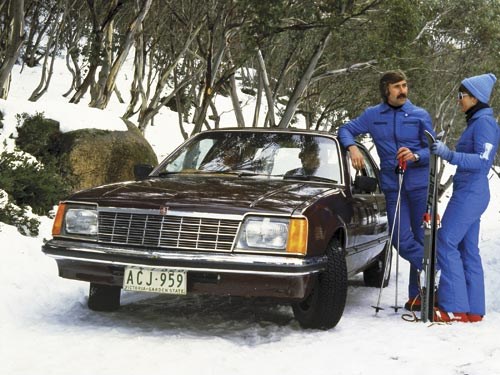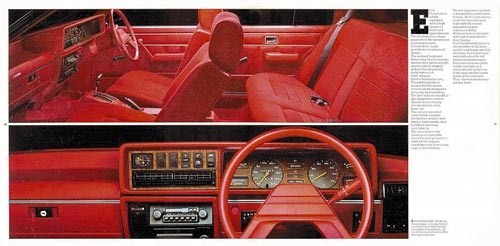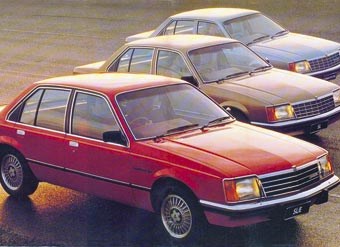Holden VB Commodore Review
 Holden VB Commodore
Holden VB Commodore

 Holden VB Commodore
Holden VB Commodore

 Holden VB Commodore
Holden VB Commodore


|
|
Holden VB Commodore
|

|
|
Holden VB Commodore
|

|
|
Holden VB Commodore
|
Aussie Original: Holden VB Commodore: It cost Holden more than a new model to develop, and market leadership, but the VB commodore was a local engineering triumph

|
|
Holden VB Commodore
|
Holden VB Commodore
The first Commodore launched on 26 October 1978 - almost 34 years ago. And it's hard to imagine any future local model ever generating the same level of excitement and anticipation again.
Given the unprecedented competition and uncertainty at the time, the VB Commodore's impact is up there with the first Holden, seeing it marked GM-H's first new direction since 1948. Even if today's management believed the VE Commodore was of similar significance in 2006, the original Commodore lifted the bar in so many areas that such an achievement may never be replicated again.
It would be easy for a visiting European or South African to dismiss the VB Commodore as another badge-engineered Opel, capped by a Holden lion and grille for Australia in place of the UK market's Vauxhall griffin. Except that the local development bill of $110 million - for just one body style - exceeded the entire XD Falcon program's $100 million budget for sedan, wagon, ute, van and long-wheelbase models. Holden's under-the-skin changes and rectification costs to make the German Opel suitable for local conditions would have delivered an all-new Kingswood! Indeed, the entire Leyland P76 program cost $20 million barely five years earlier.
Undoubted brilliance aside, because the first Commodore eventually cost Holden market leadership and sent the local operations broke, Australians still too readily blame cynical Detroit suits for forcing yet another unsuitable choice on local management. But while this was true for other local models, the VB Commodore wasn't enforced by the US. And even if it was, it ultimately wasn't a bad decision.
The switch to Commodore eventually set Holden up with an export model that could share global GM parts while meeting specific market demands. The irony is that now the Commodore's full localisation process is complete, it's likely to be the only Australian passenger car to survive beyond the current generation.
If you were around in 1975 when the final decision to go Commodore was made, almost every self-proclaimed industry expert from government and the media were suggesting that the 2.0-litre sedan was the everyday Australian car of the future - a prediction that proved astonishingly accurate for the 21st century, but not 1978! The reasoning was sound. Baby Boomers had fled the nest, the Pill made another population spurt unlikely, petrol price rises and shortages were a serious threat, and a flood of up-to-date and well-finished Japanese sedans were proving successful, despite punitive tariff barriers.
Yet the dual-purpose people movers and off-roaders needed to cover multiple-passenger applications were still a decade away. In the meantime, tough new seatbelt laws ensured that the majority of Australian households still needed a car wide enough to carry three people across the back.
Holden had to start again either way. The HQ's huge sales volumes and subsequent facelifts had worn out the tooling. The strategy of restricting the LH Torana's wheelbase to 2586mm to match the Cortina's in order for it to continue as an all-Australian model had backfired by 1975. Like the Cortina, the heavy Torana could offer no more shoulder width or leg room than its skinnier, more frugal Japanese rivals. Because the next round of European four-cylinder models would be built on similar wheelbase lengths to the Commodore (2668mm), and cars like the Mitsubishi Sigma and Mazda 626 were growing in size, the LH Torana was exposed.
The initial, most cost-effective plan was to boost the LH Torana's wheelbase to the Commodore's 2668mm - about the same as an HD Holden or AP5 Valiant. The Kingswood could then be cut back to a sleeker, wedge-shaped hatch, similar to the Rover 3500 SD1 in proportion and size, on a wheelbase of 2743mm - the same as a VE Valiant's. But market research suggested the long-wheelbase Torana was too narrow and the trimmer Kingswood was too petite for a serious Aussie family car.
Holden was then forced to adapt the new Opel Rekord, regardless of Detroit intervention, to match the next Cortina and Chrysler 180. But Holden soon encountered the same difficulties housing local sixes and V8s under a nose designed for Opel's wheezy fours. All European manufacturers at this point were merging their 2.0-litre family cars with their prestige sixes. Volvo's 244 and 264 shared the same body and wheelbase but used different fronts. The Ford Granada and Peugeot 604 shared their cabin architecture and doors with the Cortina and 504, but sat on longer wheelbases. BMW, Mercedes-Benz and Rover simply used identical exteriors regardless of engine.
For its 1977 range, Opel built the entry-level Rekord on the same wheelbase as its top-of-the-line Senator, but used different front and rear sheetmetal. Because the Senator was styled to house Opel's bulky in-line sixes, Holden had to adapt the Senator's extended front panels to the more basic Rekord cabin and boot styling to allow Holden's bigger engines to fit. This was an Australian initiative later picked up by the Germans for the Opel and Vauxhall versions of the Australian Commodore, not the other way around.
The '77 Opel Rekord exploited the same finite element analysis as the first VW Golf and Passat, both notable in Australia for their loss of ruggedness over the Beetle they ultimately replaced. For a rear-drive model, Opel's new Rekord set a benchmark in cost and efficiency within the confines of smooth European roads, but Australian requirements were never part of the brief. As the Rekord's local toughening-up process for Cortina- and Centura-rivalling duty progressed, the extent of what had already been spent - and what was still required - sent shock waves through the corporation.
Market research in these very early stages confirmed that Australians would embrace the new model as a Torana replacement, but Holden could NOT drop the Kingswood. This was one of the best-kept secrets at the time. If it had got out, it might have saved Ford management from the absolute terror they felt thinking they had backed the wrong horse with a new full-sized XD Falcon. According to Bill Tuckey's Commodore Lion King, this research was sidelined so that Rekord development could continue and replace the Kingswood as well, reflecting an internal view that Holden should set the agenda, not follow it.
As Chuck Chapman took over the reins in 1976, he uncovered the shelved research and acted. Imported Rekord wagon sheet metal created a last-minute Commodore station wagon and the HZ Kingswood remained in production.
While logically sound, this was still a disaster for Holden as there was no money left for a Kingwood replacement, or for new engines. And Holden had to maintain separate production facilities for the Commodore and Kingwood as they were the product of totally different build methods. The variations in pre-VN Commodore build dimensions and quality control were shameful, and the conditions under which workers had to put them together were appalling.
For the old Holden guard who knew the importance of full-size utes, vans, wagons and long-wheelbase models to the bottom line, Holden was still seriously at risk. A WB Kingswood based on the Statesman wheelbase was developed in the back rooms.
An initial Commodore sales spurt driven by a pioneering direct-mail campaign and a dominating Repco Round-Australia result prompted the WB Kingswood project to be shelved. Then in 1982, as buyers discovered that the old engines couldn't deliver an economy or performance boost to match Commodore's drop in size, sales nosedived.
As anxiety about fuel prices and supplies subsided, under-sized family cars were on the nose, just when Holden's cupboard was bare. The VB Commodore would neither be the first, nor the last, benchmark Australian car to bring its maker to the brink...
Unique Cars magazine Value Guides
Sell your car for free right here
Get your monthly fix of news, reviews and stories on the greatest cars and minds in the automotive world.
Subscribe

.jpg)






.jpg)



.png)



